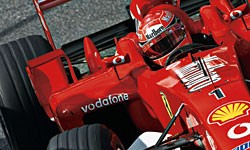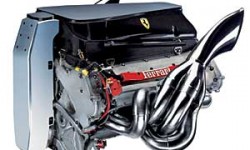
Summary
F2002
Engine: 3000 Ferrari (Type 051), V10
Total displacement: 2,997 cm3
Timing gear: 40 valves
Fuel feed: Magneti Marelli digital electronic injection
Ignition: Magneti Marelli static electronic ignition
Transmission: Semiautomatic sequential electronically controlled gearbox, limited-slip differential, seven gears plus reverse
Chassis: Carbon-fibre and honeycomb composite structure
Front suspension: Independent suspension, push-rod activated torsion springs
Rear suspension: Independent suspension, push-rod activated torsion springs
Brakes: Ventilated carbon-fibre disc brakes
Length: 4,495 mm
Width: 1,796 mm
Height: 959 mm
Front track: 1,470 mm
Rear track: 1,405 mm
Kerb weight (with water and oil): 600 Kg
Wheels: 13 inch diametre
The SKF Racing Unit
To meet the high-performance, high-speed demands of Formula One, SKF set up its racing unit in April 2001. This represents the development of one of the longest corporate relationships in Formula One. SKF began working with the late Enzo Ferrari in 1947.
The unit designs bearings that are extremely light, minimise friction, increase wear resistance and reduce rolling contact fatigue. They must minimise power loss and heat generation without affecting life performance in a low-lubrication environment.
SKF has also developed a computer simulation system that enables engineers to model the performance of bearings under different car configurations and in different racing environments. It provides a means to analyse, evaluate and improve the life of the bearing, as well as stiffness, friction and pre-load factors.
SKF provides high-efficiency sealing solutions that optimise sealing efficiency and friction torque in a high-speed environment. Other factors that SKF products must contend with include high contact pressures, high rotational and sliding speeds, high temperatures, misalignment and poor lubrication – all aspects that are among the worst conditions that a bearing must perform under.
Ferrari’s F2002 Formula One car is rated as “probably the best technical package in 10 years.” Evolution tries to uncover some of its secrets.The mystery, the secrecy of Formula One, has long been a part of the legend of what can reasonably be described as one of the greatest sporting shows on the planet. As such, it’s no surprise that Ferrari’s technical director, Ross Brawn, offers little more than a wry grin when questioned about the finer technical details of the F2002 car.
Indeed, trying to prise information out of Ferrari about its top-performing and top-secret car is a bit like trying to mine cheese on the moon. You only strike rock.
Pressed, Brawn is prepared to say that he believes the single most important development in the F2002, compared to last year’s F2001, is its new transmission, developed over two years – an assessment that observers agree with.
“It was shortened, narrowed, made lighter,” he says. “ The casing is titanium, a first. We’ve got a lower centre of gravity, better aerodynamics [a 5 percent improvement] and a lower moment of inertia – the masses at the car’s extremes create a pendulum effect, so reducing weight on the extremes improves responsiveness.”
In fact the car is different to its predecessor in seven key areas – the engine, chassis, aerodynamics, transmission, suspension, steering and electronics. The engine is producing more horsepower. The gearshift is faster and smoother. The chassis is lighter and has better aerodynamics. The suspension is stiffer.
The Formula One teams are, of necessity, protective about their information. But such is the intensely competitive nature of the circuit, that information is “obtained,” things “get out.” Competitor manufacturers are always on the trail of the secret information that might help close performance gaps or build an advantage.
One of those on the receiving end of such information is leading Formula One commentator Mark Hughes, of the UK. He rates the F2002 as “without doubt the fastest on the track by some margin – a definite improvement on last year.
“What’s the secret of the F2002?” he continues. “I’d say its twofold. They have secured a big aerodynamic advantage, primarily due to the new transmission. And there’s a big advance in straight-line speed, which the F2001 lacked, compared to Williams.”
Hughes understands that the F2002 is generating about 840 horsepower, compared with the F2001’s 825 late last season. It is now generating about the same horsepower as the Williams BMW, which he estimates is getting 845 to 850 horsepower. “It’s as if Ferrari went away in the off season and worked out BMW’s secret. No one else has, and these two cars now have a 50 to 60 horsepower lead on the others.”
Although the secrets of an engine are some of the most jealously guarded in Formula One, manufacturers know how to work their competitors’ performances.
Here’s how it works. Recording equipment is set up at the end of a straight on the racetrack to measure the speed of a targeted car and (via a technique known as sonic measurement) the pitch of an engine, which is used to calculate the engine’s revs at a given speed. Armed with these figures and the drag coefficient of the car, which is generally known, it is possible to calculate horsepower of an engine.
“The technique” says Hughes, “is well proven.”
Concurring with Brawn, Hughes says the F2002’s advantage in aerodynamics is largely derived from the shorter, super-lightweight gearbox. “Ferrari is getting something like 300 kilograms in frontal down force, which is the difficult bit and the key to being quick with this generation of cars. They are about 10 percent ahead.”
Grand Prix editor at motor racing’s bible, Autosport, Jonathan Noble, rates the F2002 as “probably the best Formula One package for 10 years,” since 1992, when Nigel Mansell’s Williams enjoyed perhaps an even greater technical superiority.
He would add that the car has better rear-end packaging and excellent turning, but says few aspects of the car are vastly superior to the opposition. “Everything is that bit better. But it’s hard to judge the technical strength of a car when you have a master strategist in Brawn, and the best driver of a generation in Schumacher.”
According to Brawn, the car represents Ferrari’s philosophy of progress through stability. “I want the technical group as stable as possible, and that means people now are on their fourth or fifth Ferrari so they should really know what they are doing.”
He describes the development of each car – and this continues throughout the season – as a process of evolution, of refinement. “In simple terms, I said to the guys, we are not going to build a new car unless you can show me half a second faster a lap. We look for this in 100ths of seconds a lap; it’s rare to find a 10th. Two or three horsepower is a few 100ths, two or three kilos down force is a few 100ths.”
Technical advancement in the workshop is one thing, but the advancement must be proven on the track, proven to deliver real-world results. As such, the car is put through about 40,000 to 50,000 kilometres of testing each year. The Ferrari team will go through about 100 race engines a year, just to support testing.
And the result? Well, as Hughes and Noble suggest and the results seem to prove, the F2002 is one of the most advanced cars yet seen in Formula One. Some questioned its durability at the beginning of the season, asking if Ferrari had not pushed the limits too far. But those who raised their voices can now be noticed only by their silence.
The F2002 continues the remarkable run of cars that Ferrari has produced in recent seasons. The team won the constructor’s title in 1999, 2000, 2001and 2002. And now Ferrari has three driver’s titles to match: 2000, 2001 and 2002.
Brawn says that the reason for the secrecy that surrounds the technology of the car is primarily to maintain hard-earned competitive advantages. “We work tremendously hard to get what we’ve got, so we are not going to give it up easily.”
Indeed, security is extremely tight at the Ferrari factory in Maranello. As we enter, the serial number of my laptop is recorded at the check-in to ensure that I don’t swap it for another one, one that just might contain a few of those classified secrets. There is a sign forbidding cameras to be taken onto the premises without express permission.
But the greatest risk to security, says Brawn, is that key members of the Ferrari team could be bought out by competitors, taking their secrets with them. High premiums are paid in Formula One circles for those with such knowledge.
Of course, the mystery and the secrecy add to the drama of the Formula One circus.
“The gladiators go out on a Sunday afternoon and do battle, and their chariots are the things we put together,” Brawn says. “If a wheel falls off the chariot, it ain’t going nowhere. No one will tell you how they put the chariots together, or you’ll lose the vital edge.
“Part of the theatre of Formula One is that people are turned on by the technology and turned on by the myth of the technology and turned on by that little bit of espionage and gamesmanship that surrounds it all – I must admit, I am.”
David Passey
Appelberg journalist and co-editor of Evolution magazine
photos Antonello Nusca, lat and Ferrari






